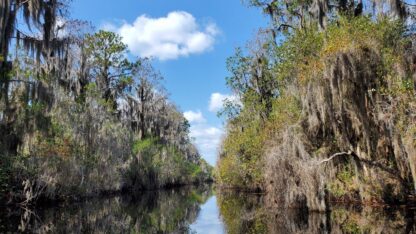A proposal to ban future mining near the edge of the Okefenokee Swamp and its vast wildlife refuge received a hearing Tuesday before a panel of Georgia lawmakers, who asked no questions of testifying experts and advocates before adjourning without a vote.
Republican Rep. Darlene Taylor of Thomasville has persuaded a bipartisan group of 90 fellow lawyers to co-sponsor House Bill 71, which would prohibit the state from granting mining permits along Trail Ridge on the swamp’s eastern boundary.
The proposed ban languished for most of the legislative session and missed the deadline last week for bills to pass the House or Senate and still be eligible for a vote by the other chamber. Regardless, it wouldn’t stop the mining application Twin Pines minerals currently has before Georgia regulators to mine titanium less than 3 miles (4.8 kilometers) from the Okefenokee National Wildlife Refuge.
Twin Pines has been seeking government permits to mine outside the largest U.S. refuge east of the Mississippi River since 2019. Federal scientists have warned that mining near the Okefenokee’s bowl-like rim could damage the swamp’s ability to hold water. Interior Secretary Deb Haaland has declared the proposed mine poses an “unacceptable risk” to the fragile ecosystem at the Georgia-Florida line.
Taylor urged a House subcommittee hearing her bill Tuesday to “protect our gift of nature.” Even if it doesn’t pass the legislature this year, the measure could still move forward in 2024.
“It cannot be replaced,” she said of the Okefenokee. “A miscalculation cannot be corrected. Permanent damage to the ecosystem cannot be ruled out and cannot be fixed if it happens.”
Whether Twin Pines will be allowed to mine on 773 acres (312 hectares) is completely up to Georgia state officials, as the federal government relinquished any permitting authority over the Twin Pines project following a rollback of environmental regulations under President Donald Trump.
The Okefenokee National Wildlife Refuge covers nearly 630 square miles (1,630 square kilometers) in southeast Georgia and is home to alligators, bald eagles and other protected species. The swamp’s wildlife, cypress forests and flooded prairies draw roughly 600,000 visitors each year, according to the U.S. Fish and Wildlife Service.
“The astounding thing about the Okefenokee is that the hydrology of the swamp is still intact,” said Michael Lusk, the refuge manager and a Fish and Wildlife Service biologist. “The ecosytem you see there today is essentially the same as when the first people saw its dark-flowing waters.”
Representatives for Twin Pines spoke out forcefully against any ban on mining outside the swamp. Even though Taylor’s bill wouldn’t affect the Alabama-based company’s pending permit applications, it would prevent Twin Pines from applying later to expand mining operations in the area.
In a video played for the subcommittee, Twin Pines President Steve Ingle insisted his company could mine the area safely.
“There’s no way we would do anything to harm the swamp which would expose us to regulatory actions and place our investment at risk,” Ingle said.
Lewis Jones, an attorney for Twin Pines, told lawmakers that land the company owns outside the Okefenokee contains minerals worth billions of dollars. He said Twin Pines has the right to “use this land to recover that value.”
“What I can guarantee is you will end up in court” if Taylor’s bill becomes law, Jones said. “This is a tremendous potential risk to the state of Georgia.”
The Georgia Environmental Protection Division is wrapping up a 60-day public comment period on its draft plan for how Twin Pines would operate its mine and mitigate potential impacts to the swamp. The agency’s director, Rick Dunn, said it could take “several days to several months” for a final mining plan to emerge once the comment period ends next week.
A final mining plan is required for Twin Pines to qualify for permits, which would need another round of review before being approved.









